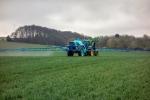H2020 ROBS4CROPS Project: Robots to protect crops
- Type Project
- Status Signed
- Execution 2021 -2024
- Assigned Budget 6.834.121,5 €
- Scope Europeo
- Main source of financing Horizon 2020
- Project website Proyecto ROBS4CROPS
Agriculture is susceptible to labor costs and shortages, and making farming practices more efficient and sustainable is critical. The EU-funded ROBS4CROPS project is a vital catalyst for accelerating high-tech robotics and automated technologies in the European food and agriculture industry. Building on existing farm machinery, standards, and best practices, the four-year project will shape and deliver a flexible, modular, and fully autonomous system ready for large-scale commercial trials. Trials will be conducted in collaboration with commercial farms and business leaders in France, Greece, Spain, and the Netherlands. ROBS4CROPS will significantly reduce farmers' reliance on hired labor, increase safety, reduce input use, and reduce the overall carbon footprint of food production.
The project is progressing as planned.
- In WP1 (Ecosystem Building), co-design sessions continued with a variety of stakeholders.
- In WP2 (Smart Implements), the smart sprayers and weeders were completed, particularly through the installation of sensors to monitor the operation of the weeders. ISOBUS TIM was (partially) implemented.
- In WP3 (Autonomous Vehicles), the retrofitting of two conventional tractors for autonomous operation began and is almost complete. Lidar-based navigation was implemented to overcome the lack of reliable RTK-GNSS signals for pilots in Greece and Spain.
- In WP4 (Farming Controller), the framework for communication between vehicles, implements, and the ERP was further developed and widely deployed in the field. Work has been done on resource orchestration and optimization.
- In WP5 (Tests), component testing and integrated system testing have been performed for the four robotic systems.
- In WP6 (Large-Scale Pilots), work on the large-scale pilots was coordinated, ensuring that scientific measurements were performed to assess the KPIs defined above, and coordinating between technical developers and stakeholders involved in the pilots.
- In WP7 (Socioeconomics and Ethics), the focus was on a social cost-benefit analysis of agricultural robotics for each of the large-scale pilots. This work has resulted in a series of conference presentations and a journal article.
- WP8 (Exploitation, Communication, and Dissemination) redesigned the project website, carried out social media campaigns, and supported the outreach efforts of all partners. Work also continued on developing a comprehensive IP strategy for the entire project. One outcome is that open source may be the best strategy for leveraging some of the project's results.
- WP9 (Management) maintained contact with the European Commission, coordinated the project, organized project meetings, and ensured the timely delivery of all reports. Overall, the project is well positioned to tie up loose ends and demonstrate autonomous robotics in all four pilots during the final year of the project.
The most significant challenge facing European agriculture is the cost and shortage of labor. Robots have replaced manual labor in several sectors of the economy. Agricultural robots have not yet achieved widespread acceptance. The ROBS4CROPS vision is an agricultural sector in which robots replace humans in all heavy and unpleasant work. From a technical perspective, agricultural robots fail to reach their potential because they are used as standalone units rather than as part of a complete and innovative robotic system.
From a non-technical perspective, agricultural robots do not fit well with current farming practices and agricultural standards and are not supported by a stakeholder ecosystem. ROBS4CROPS will address the technical challenges by creating a robotic farming solution consisting of three elements: smart implements, autonomous vehicles, and the agriculture controller. Existing farm implements and tractors will be upgraded to work alongside existing agricultural robots as parts of a robotic system. Development and testing will take place in real-world farming environments (real operating conditions), across four countries, in iterative cycles, and in close collaboration with stakeholders. ROBS4CROPS will address the non-technical challenges by utilizing existing agricultural standards, utilizing existing machinery (thus reducing the initial investment required), and addressing the lack of maintenance, insurance, financing, and training.
Regulatory compliance, roboethics, and socioeconomic impact will be explicitly addressed. Robotics offers the opportunity to develop new business models. The construction of the agricultural robotics ecosystem will be carried out iteratively, in parallel with technical development. The complete robotic system (technical and non-technical) will be demonstrated at scale in pilots in four European countries.
The most significant challenge facing European agriculture is the cost and shortage of labor. Robots have replaced manual labor in several sectors of the economy. Agricultural robots have not yet achieved widespread acceptance. The ROBS4CROPS vision is an agricultural sector where robots will replace humans in all heavy and unpleasant jobs!
From a technical perspective, agricultural robots fail to reach their potential because they are used as standalone units rather than as part of a complete and innovative robotic system. From a non-technical perspective, agricultural robots do not fit well with current farming practices and standards and are not supported by a stakeholder ecosystem. ROBS4CROPS will address technical challenges by creating a robotic farming solution consisting of three elements: smart implements, autonomous vehicles, and the farm controller. Existing farm implements and tractors will be upgraded to operate alongside existing agricultural robots as parts of a robotic system. Development and testing will take place in real-world farming environments (real operating conditions), across four countries, in iterative cycles, and in close collaboration with stakeholders.
ROBS4CROPS will address non-technical challenges by utilizing existing agricultural standards, utilizing existing machinery (thus reducing the initial investment required), and addressing the lack of maintenance, insurance, financing, and training. Regulatory compliance, roboethics, and socioeconomic impact will be explicitly addressed. Robotics offers the opportunity to develop new business models. The construction of the agricultural robotics ecosystem will be carried out iteratively, in parallel with technical development. The complete robotic system (technical and non-technical) will be demonstrated at scale in pilots in four European countries.
ROBS4CROPS will develop components and integrate them into a practical autonomous robotic system for crop protection. Non-technical aspects: Operation: The consortium will provide business models for launching ROBS4CROPS solutions alongside existing infrastructure and technology that farmers already possess. Robots-as-a-service business models will be examined to identify new ways to accelerate the adoption of robotic technologies.
Ecosystem Building: An innovation ecosystem is "the set of actors, activities and artifacts, and the institutions and relationships, that are important to the innovative performance of an actor or a population of actors. This project will make full use of existing Digital Innovation Hub projects and reach out to a broad group of ecosystem actors and expose them to their needs and concerns. Ethical Issues: We will apply ethical theory to review specific applications of agricultural robotics and situate questions about smart farming within the broader ethical debate about the increased deployment of AI and robotics systems to perform tasks traditionally performed by humans. Socioeconomic Costs and Benefits:
ROBS4CROPS will assess net environmental costs and benefits and present the results in a web-based tool that allows key stakeholders to evaluate the economic impact of various levels of implementation. For each scenario, externalities, non-market costs, and benefits of robotic systems compared to conventional systems will be assessed. Large-scale pilots: A realistic testing ground will be established in each pilot country to compare conventional farming operations with the recently introduced ROBS4CROPS solution. Large-scale ROBS4CROPS pilot projects will connect with many farmers and other stakeholders. Technical aspects: The robotic farming solution consists of three components: smart implements, autonomous vehicles, and the agriculture controller. Smart implements: ROBS4CROPS will equip agricultural implements with new sensor systems and develop methodologies to evaluate the operations performed. The project will use ISOBUS (ISO 11783) for communication between vehicles and implements.
The ISOBUS Task Controller function will ensure that a prescription map intended for a conventional tractor can also be applied by a robot. Autonomous Vehicles: ROBS4CROBS will implement fully autonomous behavior for autonomous agricultural vehicles. This will be achieved through sensors, models, and software implemented in the robot itself. Full autonomy also includes task-level autonomy, which includes the (re)scheduling of tasks in response to goals and conditions, such as reversing a crop row that turns out to be blocked by an obstacle and then continuing work on the next row; or "please weed this field before tonight."
This will be achieved through planning and scheduling algorithms that will leverage a digital twin of each vehicle. Farming Controller: ROBS4CROPS will offer a fully autonomous robotic system for crop protection by transferring state-of-the-art control and synchronization systems derived from industrial manufacturing to the agricultural sector. The Farming Controller will be designed and implemented to establish seamless communication between all resources and sensors with a digital representation of the field, under a common framework. The implemented model will host simulation tools as well as an upper-layer control module.
- STICHTING WAGENINGEN RESEARCH (WR)







